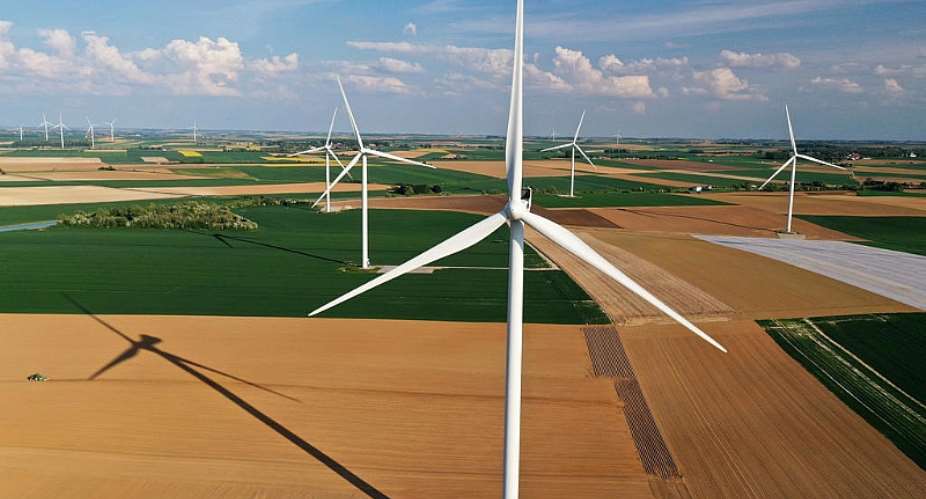Energy sources such as wind and solar produced a record 10% of global electricity in the first half of 2020, while coal fell 8.3%, new analysis shows. Experts say however that this shift in consumption, accelerated by the Covid-19 pandemic, is not enough to limit climate change in the long term.
Renewables accounted for 1,129 terawatt-hours in January-June, compared with 992 in the first six months of 2019, a 14 percent increase, according to a report by the independent Ember energy think tank, based in the UK.
Electricity generated from coal -- the most polluting fossil fuel -- fell 8.3% in the first half of 2020.
"This breaks a new record, following on from a year-on-year fall of 3% in 2019, which at the time was the biggest fall since at least 1990," the report said.
"For the first time, the world's coal fleet ran at less than half of its capacity this year."
Dave Jones, senior electricity analyst at Ember said that while 30% of coal's decline this year could be attributed to increased wind and solar generation, the rest was likely due to the economic slowdown caused by Covid-19.
He also points to mild winters in many countries which meant electricity demand for heating was lower.
Ember compiled data collected from 48 countries making up 83% of global electricity production.
It showed that many major economies -- including China, the United States, India, Japan, Brazil and Turkey -- now generate at least 10% of their electricity through wind and solar.
EU generates 21% renewable energy
Britain and the European Union generated 21% and 33% of their power from renewables, respectively.
Star performer Germany rose to 42%, while on the other end of the scale; Russia generated just 0.2% of its electricity from wind and solar.
Overall, the percentage of power drawn from wind and solar has more than doubled from 4.6% in 2015 -- the year of the landmark Paris deal on climate change.
Wind and solar generated almost as much CO2-free power as nuclear power plants, which generated 10.5% of global electricity in the first half of 2020, a figure unchanged from 2019.
"From 2015 it's an incredible amount of growth (in solar and wind), but even at 10% it's not completely transformational," Dave Jones told AFP.
The key is to look at how quickly the emissions are falling, and he points out that it's not fast enough.
"Thirty percent of fossil fuel emissions globally are just from coal power plants, so coal fired power generation needs to collapse quickly in order to limit climate change," said Jones.
Ember says that government stimulus packages will need to be forthcoming to keep up the momentum in renewables, especially after the slowdown during the pandemic.
"We have the solution, it's working, it's just not happening fast enough."
Under the Paris Agreement, nations committed to limit temperature rises to "well below" two degrees Celsius (3.6° Farenheit) above pre-industrial levels, mainly through sweeping emissions cuts.
The accord also aims for a cap of at least 1.5°C of global warming.
To reach this, the United Nations says emissions must fall 7.6% annually this decade.
The Intergovernmental Panel on Climate Change says that coal use needs to fall 13% every year this decade to keep the 1.5°C objective.
China, the world's leading polluter, reduced its coal production just two percent so far this year despite its economic slowdown caused by the pandemic, but it is far from planning to give it up.





 Minority will expose the beneficial owners of SML, recover funds paid to company...
Minority will expose the beneficial owners of SML, recover funds paid to company...
 Prof. Opoku-Agyemang has ‘decapitated’ the NPP’s strategies; don’t take them ser...
Prof. Opoku-Agyemang has ‘decapitated’ the NPP’s strategies; don’t take them ser...
 Abubakar Tahiru: Ghanaian environmental activist sets world record by hugging 1,...
Abubakar Tahiru: Ghanaian environmental activist sets world record by hugging 1,...
 Prof. Naana Opoku-Agyemang will serve you with dignity, courage, and integrity a...
Prof. Naana Opoku-Agyemang will serve you with dignity, courage, and integrity a...
 Rectify salary anomalies to reduce tension and possible strike action in public ...
Rectify salary anomalies to reduce tension and possible strike action in public ...
 Stop all projects and fix ‘dumsor’ — Professor Charles Marfo to Akufo-Addo
Stop all projects and fix ‘dumsor’ — Professor Charles Marfo to Akufo-Addo
 Blue and white painted schools will attract dirt shortly – Kofi Asare
Blue and white painted schools will attract dirt shortly – Kofi Asare
 I endorse cost-sharing for free SHS, we should prioritise to know who can pay - ...
I endorse cost-sharing for free SHS, we should prioritise to know who can pay - ...
 See the four arsonists who petrol-bombed Labone-based CMG
See the four arsonists who petrol-bombed Labone-based CMG
 Mahama coming back because Akufo-Addo has failed, he hasn't performed more than ...
Mahama coming back because Akufo-Addo has failed, he hasn't performed more than ...
